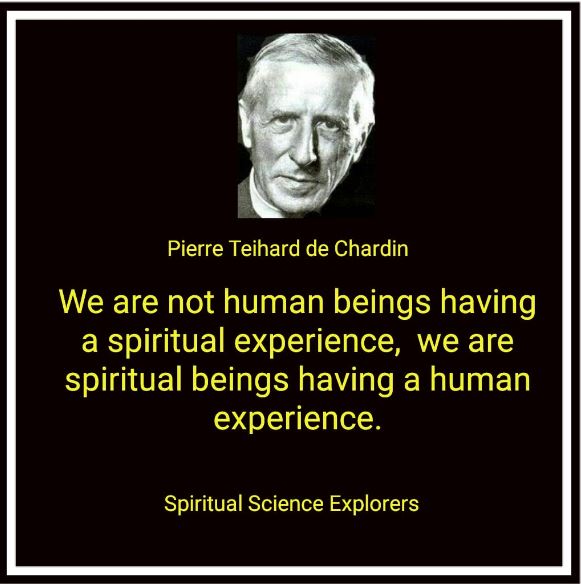Spiritual and Science - The Hyperphysics of Pierre Teilhard de Chardin
 |
| Spiritual and Science - The Hyperphysics of Pierre Teilhard de Chardin |
Pierre Teilhard de Chardin, a French philosopher, paleontologist, and Jesuit priest, was a visionary thinker who made significant contributions to both science and spirituality. He is renowned for his integration of evolutionary science with theology, proposing a novel concept known as the Omega Point. This article delves into the life and ideas of Teilhard de Chardin, exploring his groundbreaking concepts and how they shaped our understanding of the universe and our place within it.
Early Life and Influences
Born on May 1, 1881, in Orcines, France, Pierre Teilhard de Chardin grew up in a devout Catholic family. His early exposure to nature during childhood instilled in him a deep sense of wonder and curiosity about the natural world. As he grew older, Teilhard's passion for science and his spiritual beliefs began to converge, laying the foundation for his groundbreaking work in later years.
Teilhard's Scientific Journey
Teilhard's academic pursuits led him to study geology, paleontology, and biology. He participated in several scientific expeditions, including the discovery of the Peking Man in China, which significantly impacted his understanding of human evolution. Throughout his scientific journey, he acknowledged the inherent interconnectedness of all life forms and saw evolution as a spiritual process driving the universe towards a higher state of complexity.
The Omega Point Theory
One of Teilhard de Chardin's most influential ideas is the concept of the Omega Point. He envisioned the universe as a dynamic, evolving entity with a purposeful trajectory. According to his theory, all of creation is moving towards a convergence point of ultimate complexity and consciousness—the Omega Point. This idea transcends scientific boundaries and postulates a profound unity between science, spirituality, and the destiny of the cosmos.
Bridging Science and Spirituality
Teilhard firmly believed that science and spirituality were not conflicting domains, but rather complementary aspects of human understanding. He contended that the process of evolution not only involved physical changes but also a spiritual ascent towards higher levels of consciousness. His unique perspective challenged the prevailing notion of a dichotomy between faith and reason, opening new avenues for dialogue between the scientific and religious communities.
Controversies and Challenges
Teilhard de Chardin's revolutionary ideas faced opposition from both the scientific and religious establishments. Some critics accused him of straying from traditional religious beliefs, while others criticized the speculative nature of his Omega Point theory. Despite these challenges, Teilhard remained steadfast in his conviction that the convergence of science and spirituality was vital for humanity's progress.
Legacy and Impact
Although not fully recognized during his lifetime, Pierre Teilhard de Chardin's ideas have left a profound impact on various disciplines. His works have inspired theologians, philosophers, and scientists alike to explore the interconnectedness of the universe and seek harmony between scientific inquiry and spiritual reflection. The Omega Point theory, in particular, continues to influence modern discussions on the purpose and direction of human existence.
Conclusion
Pierre Teilhard de Chardin's hyperphysics, which merged evolutionary science and spiritual contemplation, remains a significant intellectual legacy. His profound vision of the Omega Point and the unity between science and spirituality challenges us to rethink our understanding of the universe and our role within it. As we continue to explore the mysteries of existence, Teilhard's ideas remind us that the search for knowledge and meaning can be both a scientific and spiritual journey.
FAQs
1. What is the Omega Point theory
The Omega Point theory, proposed by Teilhard de Chardin, suggests that the universe is evolving towards a point of ultimate complexity and consciousness, representing a convergence of all creation.
2. Was Teilhard de Chardin's work accepted during his lifetime
No, Teilhard's ideas faced opposition and were not fully recognized during his lifetime, but they gained traction after his death.
3. How did Teilhard bridge science and spirituality
Teilhard saw science and spirituality as complementary aspects of understanding, believing that evolution involved both physical and spiritual advancement.
4. What impact did Teilhard's ideas have on modern thought
Teilhard's ideas continue to inspire theologians, philosophers, and scientists to explore the interconnectedness of the universe and seek harmony between science and spirituality.
5. Where can I learn more about Teilhard de Chardin's work
To delve deeper into Teilhard's ideas, you can explore his written works and various scholarly publications discussing his contributions to hyperphysics.
Post a Comment for "Spiritual and Science - The Hyperphysics of Pierre Teilhard de Chardin"